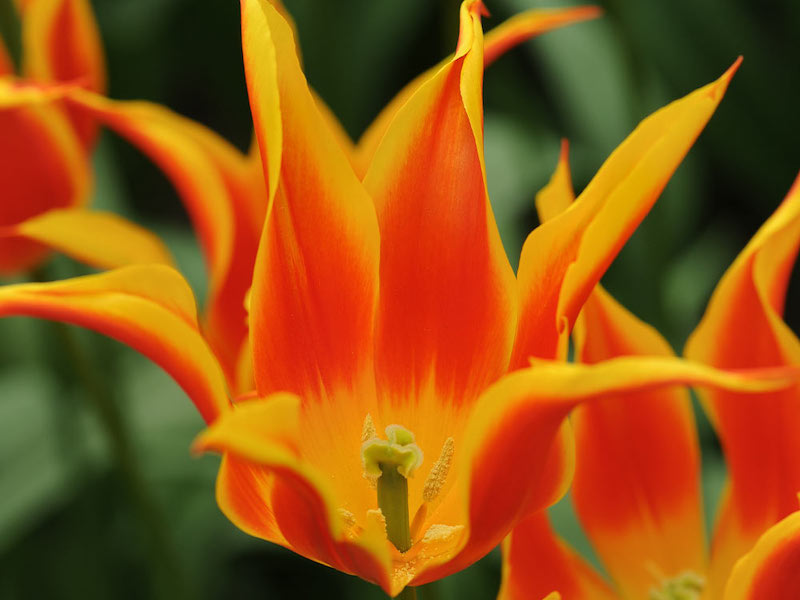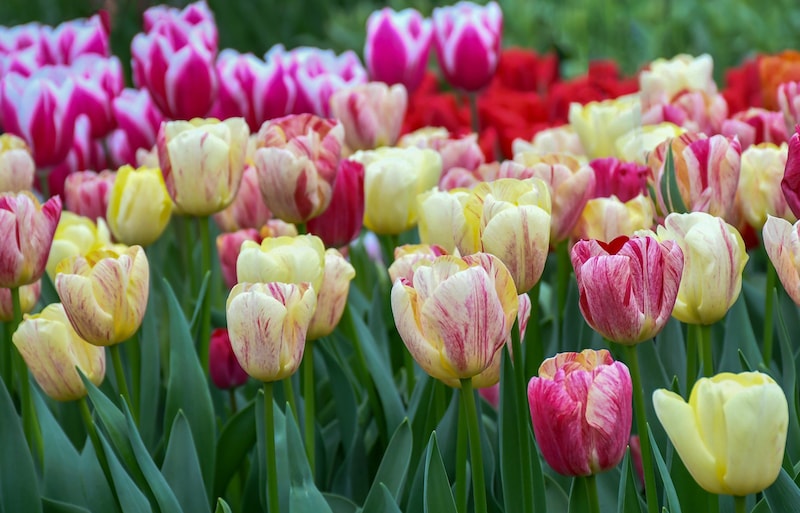If you want to grow spring-flowering bulbs, we’ve got you covered. Here’s a helpful collection of the best independent articles, YouTube videos and Instagram posts from the internet.
After a long winter, the fresh green shoots of spring bulbs are the delightful heralds of warmer and brighter days ahead. Such a simple, economical and satisfying way to cheer up your garden, there’s a huge selection of beautiful varieties from which to choose. Gather some advice from these gardening experts and look forward to a fantastic display from February through to May.
Contents
- Best advice on when to plant spring-flowering bulbs
- Best advice on where to plant spring-flowering bulbs
- Best advice on how to plant spring-flowering bulbs
- Best advice on how to make a bulb ‘lasagne’
- Best spring-flowering bulb varieties to grow
Best advice on when to plant spring-flowering bulbs

Don’t plant tulips until November
Image: Tulip ‘Fly Away’ from Suttons (New)
September to November is the traditional time to plant spring-flowering bulbs, as most of the experts agree, but there is definitely room for manoeuvre. Whether you plant in autumn or winter, Mandy at Mandy Can U Dig It is certain of one thing – summer is the perfect time to plan your spring display, visualise your dream look and purchase the bulbs you want. Her excellent article includes a handy chart of planting times for common varieties.
The seasons seem to be shifting, according to Sean at Sean’s Garden who observes that the harshest weather often waits until February to arrive these days. He noticed that this change was prompting his daffodils to start flowering in December rather than waiting for spring. His answer is to plant daffodil bulbs in January and they bloom successfully in March and April the same year.
Tulips lend themselves to late autumn planting in the expert view of Alan at Down to Earth, who says damp and cool soil isn’t their ideal environment so spending less time in it suits them better. He gets his other bulbs in the ground earlier, but waits until November or December to plant his tulips.
The Frustrated Gardener Dan agrees, noting that leaving tulip planting until the weather grows cold combats, or at least minimises, diseases like tulip fire that causes ugly spots on the leaves and flowers. But he says it’s wise to plant narcissi bulbs in late summer or autumn if you want top quality blooms, so they can establish themselves in warmer soil before winter kicks in.
Best advice on where to plant spring-flowering bulbs

Bring borders to life with these unusual split cup daffodils
Image: Daffodil ‘Rainbow Butterflies Mixed’ from Suttons
Bulbs can look fabulous in garden borders or naturalised under trees as Alexandra, The Middle Sized Gardener, confirms in her inspiring article about where to plant spring-flowering bulbs. She takes her lead from head gardener Lucy Adams at Doddington Place Gardens, who creates colour-themed swathes with an assortment of bulbs that flower from February to June for several months of interest.
Dan, aka, The Frustrated Gardener, loves to create a bulb “theatre” using his vast collection of pots with different heights and girths according to the bulb variety. His haul includes lots of tulips, irises and crocuses. He shifts the pots around so there’s always a flower at its best taking centre stage.
Another fan of container planting is Katy in the Garden, who shares her lessons learned from spring-flowering bulbs. She loves to plant them in lots of tiny pots, but has discovered that some flowers, like tulips, look much better en masse in a larger container. One of her top tips is to use sun and shade when bulbs start developing in spring, moving pots to the best position to either slow down or speed up flowering, and get a longer display.
If you’re planning your garden’s spring bulb display, designer Lucia Bukova suggests planting them in clusters of different shades, rather than lines or rows, unless you’re growing them as cut flowers. In her very helpful video she shares the dos and don’ts of spring bulb design, including why it pays to invest in large numbers of bulbs if you can.
The beauty of bulb-grown spring flowers can do wonders to brighten up a dark and dingy allotment, according to Tony of Simplify Gardening. In his informative video, he details how he planted 300-400 bulbs in the fruit bed, where he grows figs, goji berries and small trees, to bring a welcome splash of colour to his plot from February to May.
MT O’Donnell from The Pink Wheelbarrow says it’s a great idea to pop in some spring-flowering bulbs to brighten up a dull corner of the garden. She tried planting crocus bulbs in a dark, dry place under some conifers, with wonderful results, and shares a lovely photo of her crocus shoots bursting out of the ground – such an encouraging sight in February.
Best advice on how to plant spring-flowering bulbs

Make room for new daffodil varieties like the scented ‘Passionale’, ideal for cutting
Image: Daffodil ‘Passionale’ from Suttons (New)
Catherine of Growing Family’s excellent guide to bulb planting runs step-by-step through her own process. She says the first job should be loosening up the soil, getting rid of weeds and, ideally adding some compost to provide nutrients for the bulbs and boost flower production.
How deep you should plant your bulbs depends on the variety. In her well illustrated article on how to plant spring bulbs, Carol, The Sunday Gardener, demonstrates the way to do it using a long-handled bulb planter for minimum bending, and helpfully lists her recommended depths for the most popular bulbs.
Common advice is to give bulbs a bit of space around them when you’re planting them, but Michael at Mr Plant Geek says that positioning them close together gives them more support when the stems get taller. That’s just one of his 11 very handy tips for planting spring bulbs.
Jessie at Plot 37 plants her spring bulbs on the allotment and uses them mostly for cutting. In her chatty video (forward to 14:30 for the bulb section) she explains how she groups bulbs in simple rows in the dahlia plot after lifting tubers for winter storage. She suggests top-dressing with manure and some meshing to keep squirrels away.
After flowering, most spring bulbs can stay in the ground and will be set to create a fresh display year after year, but there are some exceptions, according to Matt at Grow Like Grandad. He advises lifting, drying and storing tulip bulbs after flowering to plant again in spring. This makes it easy to separate the small offset bulbs they produce, and grow them on separately until they’re mature enough to bloom.
Best advice on how to make a bulb ‘lasagne’

Bulb ‘lasagnes’, like this tulip & muscari mix, can have many layers that flower in succession, or just 2-3
Image: Visions BV, Netherlands
One of the most popular ways to plant bulbs for a long-lasting spring display is in layers in a large pot – otherwise referred to as a bulb ‘lasagne’. Tony at Simplify Gardening explains the concept really well. His video demonstrates how to build an ambitious five-layer lasagne, with assorted tulips at the bottom, followed by daffodils, narcissi, leucojum and crocus, a combination that should flower in succession from early to late spring. One top tip is to avoid the bulbs touching each other in the pot.
Catherine at Growing Family agrees that layering is a wonderfully clever way to create a beautiful display of flowers that goes on for months. On her blog she gives very clear instructions for making a bulb lasagne, with great pictures for extra guidance and suggestions for bulb varieties to choose.
To give a really good illustration of what goes on inside a bulb lasagne pot, Alan at Down to Earth has sliced a couple of containers in half, exposing the way the layers should look. He recommends choosing a pot that’s at least 30cm in diameter (or 15-litre volume) and selecting large bulbs that will flower at different times, placing the latest flowering in the bottom layer and the early bloomers at the top.
Katrina at Homegrown Garden also loves the bulb lasagne concept. Her excellent step by step video reveals the neat trick she uses to stop squirrels and rodents digging up the bulbs for lunch. Loading up her pots with three decks of bulbs, she buries a layer of chicken wire under the top layer of compost – apparently the bulb shoots will navigate their way through – and finishes with winter bedding plants for instant colour.
Mr Plant Geek squeezes in an extraordinary number of bulbs into his container as he guides us through the bulb lasagne method, reminding us that each bulb needs to be planted at three times its own depth. He places the largest variety at the bottom, making sure the root end is facing downwards, and leaving room at the top for primrose and heather plants.
Best spring-flowering bulb varieties to grow

Fritillaria feature attractive nodding flower heads in white, pink or checkered purple
Image: Visions BV, Netherlands
Louise at Blooming Lucky has her eye on some of the more unusual bulb varieties in her list of bulbs to plant in autumn. With flowers for borders, pots, in grass and under trees, her striking selection includes fritillaria; pushkinia; muscari; and ‘snowflakes’ with green dots at the base of each petal. She also adds tulips and alliums to the mix.
If you’d like to follow the lead of Bex at Botanical Tales, who grows and preserves flowers to create art, take inspiration from images of tulips she has grown in a stunning swathe of whites, pinks and reds. She lifts the blooming plants individually, with the bulb still attached, and hangs them to dry.
Katy in the Garden is particularly fond of miniature narcissus ‘Tete a Tete’, as shown in her photo of them in all their glory peeping out from a pot alongside purple pansies.
The spring bulb of choice for Becky at Sow Much More is the lovely snakeshead fritillary with its checkerboard pattern flowers nodding in her wild flower area. Classified as vulnerable in the UK and on the red list for endangered species, she urges us to plant them to help regeneration and encourage bees.
With so much fabulous inspiration it’s time to start planning your spring-flowering bulb displays. Armed with this rich seam of expert advice, you’ll be well on the way to making next spring’s garden, container or allotment show the best one yet.
Feature image: Tulip Colour Carnival from Suttons
Last Updated on December 3, 2025 by Suttons Horticultural Team






Love Jessie@plot37!